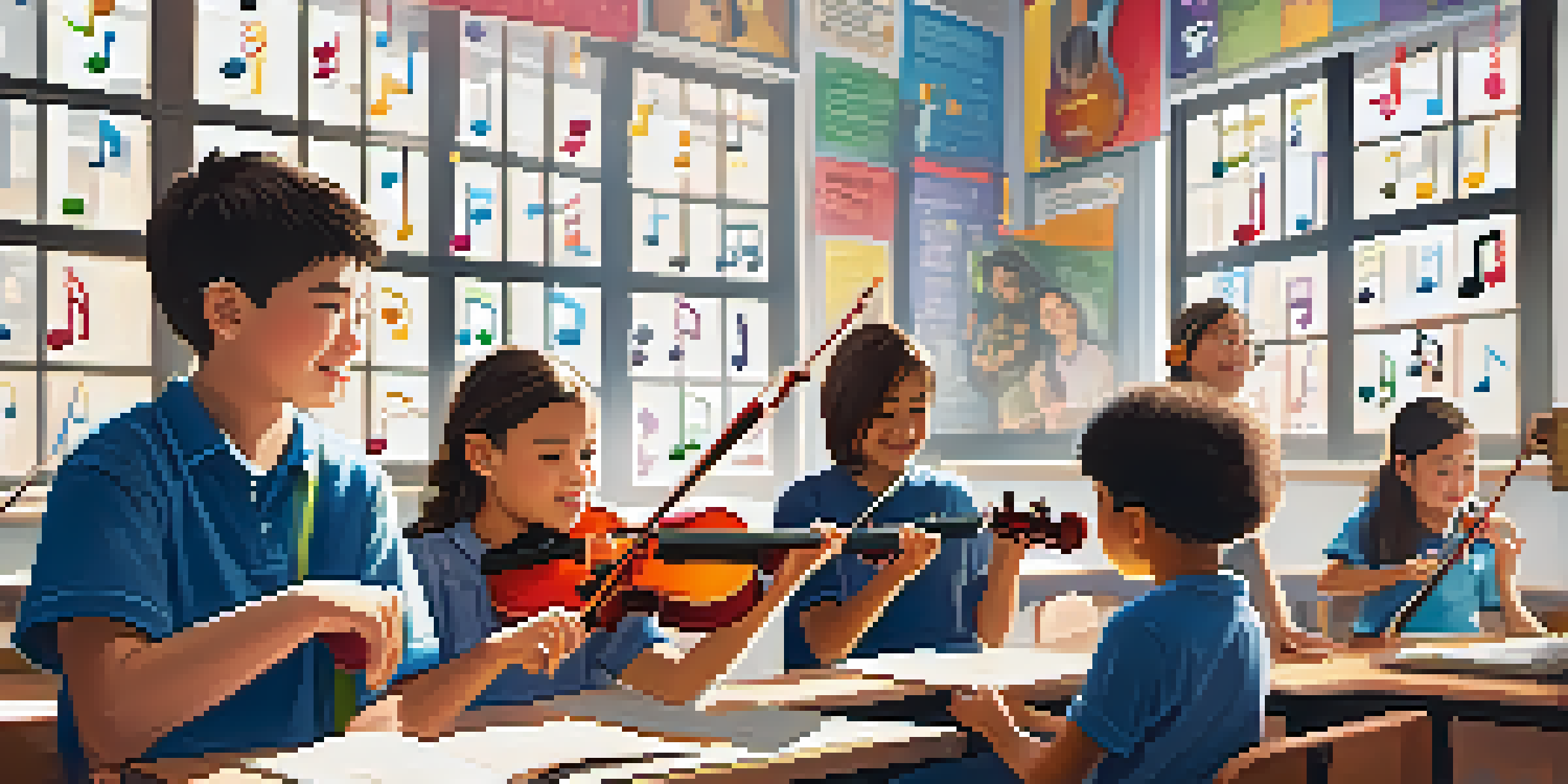California's Music Education: A Historical Perspective on Growth

The Roots of Music Education in California
California's music education traces its roots back to the early 20th century, where music was often an extracurricular activity in schools. It wasn't until the 1960s that music programs began to gain traction, largely influenced by the cultural shifts of the time. The rise of folk music, rock 'n' roll, and the burgeoning counterculture movement played a vital role in shaping public interest in music education.
Music can change the world because it can change people.
As more communities recognized the value of music in fostering creativity and teamwork, school boards started to allocate funds specifically for music programs. This grassroots movement laid the groundwork for what would become a more structured approach to music education across the state. Parents, educators, and musicians united to advocate for the inclusion of music as a core subject in schools.
By the late 1970s, California had established a framework for music education, with many districts implementing comprehensive music curricula. This period was characterized by a growing acknowledgment that music education not only nurtured artistic talent but also enhanced cognitive abilities and social skills among students.
Legislation and Policy Changes Impacting Music Education
The evolution of music education in California has been significantly influenced by legislative measures aimed at improving arts education. For instance, the California Arts Education Framework, established in the 1980s, set guidelines for integrating the arts into the educational system. This framework emphasized the importance of music as part of a well-rounded education.

In recent years, initiatives such as the California Arts Council's focus on equity in arts education have further propelled music programs in underserved communities. These policies aim to ensure that all students, regardless of background, have access to quality music education. Such efforts underscore the legislative commitment to fostering a diverse and inclusive environment for aspiring musicians.
Music Education's Historical Growth
California's music education evolved from extracurricular activities in the early 20th century to a structured curriculum by the late 1970s, reflecting societal changes and community advocacy.
Moreover, funding initiatives like the Local Control Funding Formula (LCFF) have allowed schools to allocate resources directly for arts and music programs based on local needs. This flexibility has empowered school districts to tailor their music education offerings, ensuring they reflect the interests and demographics of their student populations.
The Role of Community Organizations in Music Education
Community organizations have played a pivotal role in supporting and enhancing music education in California. From local nonprofits to statewide initiatives, these groups provide essential resources, mentorship, and performance opportunities for young musicians. Their efforts often fill gaps where school programs may fall short, particularly in low-income areas.
The only thing better than singing is more singing.
One prominent example is the California Alliance for Arts Education, which advocates for policies that support arts education, including music. By connecting educators, artists, and policymakers, the Alliance helps amplify the voices of those who believe in the power of music education. This collaboration fosters a sense of community that enriches the educational experience for students.
Additionally, organizations like Music for All and the VH1 Save The Music Foundation offer grants and instruments to schools, ensuring that music programs can thrive. These partnerships exemplify how community involvement can lead to sustainable growth in music education, creating pathways for students to explore their musical talents.
Technological Advancements Shaping Music Education
As technology continues to evolve, its impact on music education in California cannot be overlooked. Digital tools and resources have transformed the way students learn and engage with music. Online platforms provide access to a wealth of instructional materials, allowing for personalized learning experiences that were previously unimaginable.
Moreover, the integration of software and applications like GarageBand and Noteflight enables students to compose, record, and share their music easily. This hands-on approach not only enhances their technical skills but also encourages creativity and collaboration among peers. Students can now connect with artists and educators worldwide, broadening their musical horizons.
Legislative Support for Arts Access
Legislation and policies, such as the California Arts Education Framework, have aimed to improve access to music education, particularly in underserved communities.
However, it's essential to balance technology with traditional music education practices. While digital tools offer exciting opportunities, the foundational skills gained from playing instruments and participating in ensemble performances remain critical. Striking this balance will ensure that students receive a comprehensive music education that prepares them for the future.
Challenges Facing Music Education in California
Despite the progress made in music education, California still faces several challenges that threaten its growth. Budget cuts often target arts programs in schools, leading to reduced staffing and limited resources. This situation can discourage students from pursuing music education, as they may feel deprived of quality instruction and opportunities.
Additionally, the increasing emphasis on standardized testing has led many schools to prioritize core subjects like math and reading over the arts. This narrow focus can create an imbalance in students' educational experiences, neglecting the holistic benefits that music education provides. Advocates argue that music education should be viewed as an essential component of student development rather than an optional extracurricular.
Furthermore, disparities in access to music education persist, particularly in underserved communities. Low-income schools may lack the funding or resources to maintain robust music programs, leaving many students without access to the transformative power of music. Addressing these inequities is vital to ensuring that all students can benefit from quality music education.
Success Stories: Schools Making Music Education Work
Amid the challenges, numerous schools across California have successfully implemented innovative music education programs. For example, the Los Angeles Unified School District has made significant strides in expanding its music offerings, allowing students to participate in various ensembles and music classes. This commitment has not only enhanced students' musical abilities but also fostered a sense of community and belonging.
Another inspiring case is the Oakland School for the Arts, which has integrated rigorous academic programs with intensive arts training. This model demonstrates the potential for music education to coexist with a strong academic curriculum, producing well-rounded students who excel in multiple areas. The success of such schools showcases the importance of prioritizing arts education in shaping future leaders.
Challenges and Future Prospects
Despite advancements, music education in California faces challenges like budget cuts and access disparities, but there is potential for growth through community advocacy and innovative teaching methods.
These success stories highlight the resilience and creativity of educators and communities dedicated to music education. By sharing best practices and collaborating with local organizations, schools can continue to find ways to nurture the next generation of musicians, ensuring that the legacy of music education in California endures.
The Future of Music Education in California
Looking ahead, the future of music education in California holds both promise and challenges. As communities and educators continue to advocate for music programs, there is potential for further growth and innovation. Increased collaboration between schools, organizations, and policymakers can help ensure that music education remains a priority in the state's educational landscape.
Moreover, embracing new teaching methods and technologies will play a crucial role in engaging students and enhancing their learning experiences. By incorporating diverse musical genres and cultural perspectives, educators can create a more inclusive curriculum that resonates with all students. This approach not only fosters a love for music but also cultivates empathy and understanding among young people.

Ultimately, the future of music education in California depends on a collective commitment to nurturing creativity and artistic expression in students. By recognizing the profound impact of music education on personal and academic growth, stakeholders can work together to ensure that every child has the opportunity to explore their musical talents.